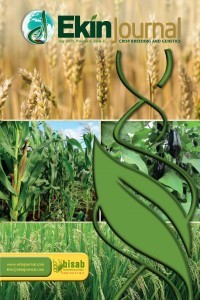A Search for Candidate Gene for Cowpea Powdery Mildew Resistance in the Southern Guinea Ecology of Nigeria
A Search for Candidate Gene for Cowpea Powdery Mildew Resistance in the Southern Guinea Ecology of Nigeria
: Powdery mildew, inheritance, genetic advance, gene action F1 hybrids,
___
- Abayomi YA, Ajibade VT, Samuel OF and Saadudeen BF (2008). Growth and yield response of Cowpea (Vigna unguiculata (L.) Walp) genotypes to Nitrogen fertilizer (NPK) application in Southern Guinea Savanna zone of Nigeria. Asian Journal of Plant Science 7: 170 – 176. Adjadi O (1996). Genetic Variability In Cowpea Vigna unguiculata (L.) Walp Under Various Crop Management Systems. Dissertation, Ahmadu Bello University, Zaria. Braun U (1987). A monograph of the Erysiphales (powdery mildews). Nova Hedwigia, Suplement 89:195–196 Braun U and Cook RT (2012). Taxonomic manual of the Erysiphales (powdery mildews).Utrecht: CBS-KNAW Fungal Biodiversity Centre. Comstock R and Robinson HR (1948). The components of genetic variance in population of biparental progenies and their use in estimating the degree of dominance. Biometrics 4: 254-266. Comstock RE and Robinson HF (1952). Estimation of the average dominance genes. Iowa S.College Press, Ames, USA. Emechebe AM and Florini DA (1997). Shoot and pod diseases of cowpea induced by fungi and bacteria. In: Advances in Cowpea Research. Singh, BB. Mohan Raj, DR, Dashiel, KE and Jackai, LEN (eds). Copublication of IITA and JIRCAS. IITA Ibadan Nigeria. pp: 176-192 Fowler JH, Baker LA and Dawes CT (2008). The Genetic Basis of Political Cooperation. American Political Science Review 102 (2): 233-34. Gawande VL and Patil JV (2003). Genetics of powdery mildew (Erysiphe polygoni D.C.) resistance in Mungbean (Vigna radiata (L.) Wilczek). Crop Protection 22:3 567-571. Gomez KA and Gomez AA (1984). Statistical Procedures for Agricultural Research, 2nd Edition. New York Chichester, Wiley. Gritton ET and Ebert RD (1975). Interaction of planting date and powdery mildew on pea plant performance. Am Soc Horti Sci 100:137-142 Heringa RJ, Vannorel A and Tazelaar MF (1969). Resistance to powdery mildew (Erysiphe polygoni D.C.) in peas (Pisum sativum L.). Euphytica 18: 163-169. James WC (1971). An illustrated series of assessment keys for plant diseases, their preparation and usage. Can. Plant Dis. Surv 51(2):39-46. Johnson HW, Robinson HF and Comstock RE (1955), Genotypic and phenotypic correlations and their implications in selection of soybean. Agron. J, 47: 477-483. Jones DF (1917). Dominance of linked factors as a means of accounting for heterosis. Proc. Natl. Acad. Sci. USA 3:310-312. Lewellen RT and Schrandt JK (2001). Inheritance of powdery mildew resistance in sugar beet derived from Beta vulgaris subsp. maritima. Plant Dis. 85: 627-631. Lohnes DG and Bernard RL (1992). Inheritance of resistance to powdery mildew in soybeans. Plant Dis. 76: 964-965. Munjal RL, Chenulu VV and Hora TS (1963). Assessment of losses due to powdery Mildew (Erysiphe polygoni) on pea. Indian Phytopathol. 19: 260-267. Ransom LM, O’Brien RG and Glass RJ (1991). Chemical control of powdery mildew in Green peas. Australas. Plant Path. 20: 16-20. Reddy KS, Pawar SE and Bhatia CR (1994). Inheritance of powdery mildew (Erysiphe polygoni DC) resistance in mungbean (Vigna radiata L Wilczek). Theor. Appl. Genet.88: 945-948. Rezende VF, Patto RMA and Corte H (1999). Genetic control of common bean (Phaseolus vulgaris) resistance to powdery mildew (Erysiphe polygoni). Genet. Mol. Biol. 22: 233-236. Robinson HF, Comstock RE and Harvey PH (1949). Estimates of heritability and degree of dominance in corn. Agron. J. 41: 353-359. Statistical Analysis System (2012). User’s Guide. Basic version 9.3, SAS institute Cary, NC, USA Shambarkar DA, Shinde YM and Baviskar AP (1997). Genetic resource evaluation against major diseases of sesame. Sesame Safflower Newsl. 12:6-10. Sillero JC, Fondevilla S, Davidson J, Vaz Patto MC, Warkentin TD, Thomas J and Rubiales D (2006). Screening techniques and sources of resistance to rusts and mildews in grain legumes. Euphytica 147: 255-272. Smith PH, Foster EM, Boyd LA, Brown JKM (1996). The early development of Erysiphe pisi on Pisum sativum L. Plant Pathol 45:302–309 Soylu EM, Soylu S and Kurt S (2004). First Report of Powdery Mildew caused by Podosphaera phaseoli (syn. Sphaerotheca phaseoli) on Cowpea (Vigna sinensis L.) in Turkey. Plant Pathology "/doi/10.1111/ppa.2004.53.issue-4/ issuetoc" Volume 53, Issue 4, page 528, August 2004 Sultan SE (2001). Phenotypic Plasticity for Fitness Components in Polygonum Species of Contrasting Ecological Breadth. Ecology 82(2): 328-343. Timmerman GM, Frew TJ, Weeden NF, Miller AL and Goulden DS (1994). Linkage analysis of er-1, a recessive Pisum sativum gene for resistance 94 bitki ıslahçıları alt birliği www.bisab.org.tr Ekin Journal to powdery mildew fungus (Erysiphe pisi DC). Theor. Appl. Genet. 88: 1050-1055. Tiwari KR, Penner GA, Warkentin TD (1997). Inheritance of powdery mildew resistance in pea. Can. J. Plant Sci. 77: 307-310. Utkhede RS, Koch CA, Menzies JG and Ehret DL (2001). Host range of a powdery mildew (Erysiphe orontii) on tomato. Can. J. Plant Sci. 81: 179-182. Warkentin TD, Rashid KY and Xue AG (1996). Fungicidal control of powdery mildew infield pea. Can. J. Plant Sci. 76: 933-935. Waraluk K, Prakit S and Peerasak S (2009). Genetics of the Resistance to Powdery Mildew Disease in Mungbean (Vigna radiata (L.) Wilczek) J.Crop Sci Biotech 27(1):37-42 Wheeler BEJ (1969). Disease in Crops. Studies in Biology 64:1-7. Wongpiyasatid A, Chotechuen S, Hormchan P and Srihuttagum M (1999). Evaluation of yield and resistance to powdery mildew, Cercospora Leaf spot and cowpea weevil in Mungbean Mutant Lines. Kasetsart Journal 33: 204-215
- ISSN: 2149-1275
- Yayın Aralığı: Yılda 2 Sayı
- Başlangıç: 2015
- Yayıncı: Bitki Islahçıları Alt Birliği
Effects of Drought on Morphological Traits of some Sunflower Lines
Yalçın KAYA, Veli PEKCAN, Nuran CICEK
Genetic Analysis of some Important Quantitative Traits in Bread Wheat (Triticum aestivum L.)
Genome-Wide Association Mapping Using a Bayesian Mixture Model for Plant Height in Oryza sativa
